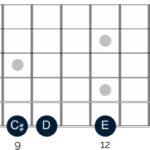The Gm, or G minor, guitar chord is often described as the sound of introspection. Like other minor chords, it evokes a sense of unease, a poignant shift between optimism and pessimism. This chord carries a weight, creating a feeling of thoughtful contemplation, and even a hint of anxiety.
Whether expressing worry about the unknown or a hopeful outlook amidst challenging circumstances, the Gm chord possesses a bright yet tentative quality, giving your music an emotional edge. Let’s delve deeper into this compelling chord and learn effective ways to play it on the guitar.
Exploring the Gm Guitar Chord
Among the vast landscape of minor guitar chords, Gm stands out as less frequently used in mainstream music than some others. However, its unique sonic character makes the Gm chord an invaluable tool for guitarists. Learning to play and incorporate the Gm chord into your playing will allow you to inject unexpected emotion, depth, and a distinctive—almost haunting—quality into your music when the song calls for it.
While it may not be a staple chord in countless popular songs, there are several approaches to playing the G minor chord on the guitar.
The Standard Gm Barre Chord
The most common and sonically full way to play the Gm chord begins at the 3rd fret of your guitar. This method utilizes a barre technique, where your index finger presses down multiple strings at once.
To play the standard Gm chord, barre your index finger across all six strings at the 3rd fret. Then, use your ring finger to fret the 5th fret of the 5th string (A string) and your pinky finger to fret the 5th fret of the 4th string (D string).
Here’s a breakdown of finger placement:
- Index finger: Barre across the 3rd fret of all six strings (low E, A, D, G, B, E)
- Ring finger: 5th fret of the A (5th) string
- Pinky finger: 5th fret of the D (4th) string
Strum all six strings downwards, starting from the low E string to hear the full Gm chord.
A diagram illustrating the full barre Gm guitar chord on the 3rd fret, showing finger placement for index, ring, and pinky fingers.
However, the barre chord technique can be challenging for guitarists who are just beginning their chord journey. Fortunately, there’s a simplified version of the Gm chord that makes accessing this emotionally resonant chord considerably easier and less frustrating to learn.
The Simplified Gm Guitar Chord
For a beginner-friendly alternative, a simplified Gm chord only requires your index finger to cover the top three strings (E, B, and G) at the 3rd fret. The primary modification in this version is that you only need to place your ring finger on the 5th fret of the 4th string (D string). Crucially, when playing this simplified Gm chord, avoid strumming the Low E and A strings.
- Index finger: Barre across the 3rd fret of the G (3rd), B (2nd), and E (1st) strings
- Ring finger: 5th fret of the D (4th) string
Strum downwards from the D string, encompassing four strings in total.
An image depicting the simplified Gm guitar chord, demonstrating finger positions for the index and ring fingers and highlighting the strings to be strummed.
While this simplified version of the Gm chord is easier to execute, it’s important to recognize that you’ll be trading some of the sonic richness and depth for ease of playability. While starting with the simplified Gm chord is a great approach for beginners, aim to gradually develop your finger strength and barre chord technique to eventually master the full barre Gm chord. This will unlock the complete sonic potential and versatility of the G minor chord.
Understanding the Notes within the Gm Chord
To truly appreciate the Gm chord, it’s helpful to understand the notes that constitute it. Like all minor chords, the Gm chord shares a close relationship with its major counterpart, the G major chord, with a key difference that defines its minor quality.
The G major chord is composed of three notes: G, B, and D. In contrast, the Gm chord consists of the notes G, Bb (B flat), and D. This single half-step difference—flattening the B note to Bb—is what transforms the bright, major sound into the richer, darker, and more melancholic sound characteristic of the minor chord. This alteration of the third interval is fundamental to the distinction between major and minor chords in music theory.
Songs That Feature the Expressive Gm Chord
The Gm chord’s inherent emotional quality makes it a powerful tool for songwriters to evoke specific feelings in listeners – which is, after all, at the heart of music. By familiarizing yourself with the Gm chord’s distinctive, slightly apprehensive character, you can train your ear to recognize its unique sense of concerned contemplation in your favorite songs.
Gm Chord in Pop Music
Right from the start, Cherry Glazerr’s track “Had Ten Dollaz” establishes a mood that’s both uneasy and unrestrained with its signature guitar riff. As Clementine Creevy’s vocals enter, the Gm chord’s palpable sense of angst is immediately evident, driving the emotional core of the song.
Consider the refrain of Brenton Wood’s memorable and thoughtful 1960s hit, “Gimme Little Sign”: “When I’m feeling down, wearing a frown…just gimme some kind of sign, girl.” This lyric, paired with the underlying Gm chord, perfectly encapsulates the chord’s worry-filled and yearning tone.
Gm Chord in Rock Music
Imagine a harmonica layered over a rhythmic progression of Gm chords, complemented by gentle harmonies and an upbeat drumbeat. This combination propelled The Beatles’ classic, “From Me to You,” to the top of the charts. The subtle yet impactful inclusion of the G minor chord introduces an unexpected emotional shift within this otherwise cheerful and catchy tune.
Surprisingly, even a band known for their sunny and carefree surf rock sound like The Beach Boys utilized the Gm chord. Listen closely to “California Girls,” and you’ll hear the Gm chord prominently featured, adding a touch of unexpected depth alongside the bright horn arrangements and their signature, captivating vocal harmonies.
From timeless rock anthems to contemporary alternative melodies like Cherry Glazerr’s “Had Ten Dollaz,” the Gm chord consistently delivers its signature angst and emotional weight.
The alternative rock genre, known for its exploration of deeper emotions, frequently embraces heartfelt acoustic songs. Plain White T’s “1, 2, 3, 4,” exemplifies this, delivering a somber yet sincere acoustic performance effectively punctuated by the Gm chord, enhancing its emotional resonance.
Gm Chord in Blues and Beyond
Whether in a pop song, a high-energy rock track, or even a blues-infused funk groove like Atlanta Rhythm Section’s “Spooky,” the Gm chord’s versatility and subtly unsettling tone shine across diverse musical styles.
Gm Chord in Country Music
Country music often explores themes of love, loss, and the complexities of life. Garth Brooks’ “Wild Horses” masterfully employs the Gm chord to underscore these sentiments, with the chord’s melancholic quality beautifully enhanced by the mournful strains of the violin.
Broaden your guitar playing skills by incorporating the Gm chord into your repertoire. Experiment with using it to inject a distinctive tone and a surge of emotion into your own songs and musical explorations.
To further expand your chord vocabulary, explore Fender Play’s comprehensive chord library, learn about various chord types, and discover valuable tips for mastering them.
If you’re ready to take your guitar journey to the next level, sign up for a free Fender Play trial today!


